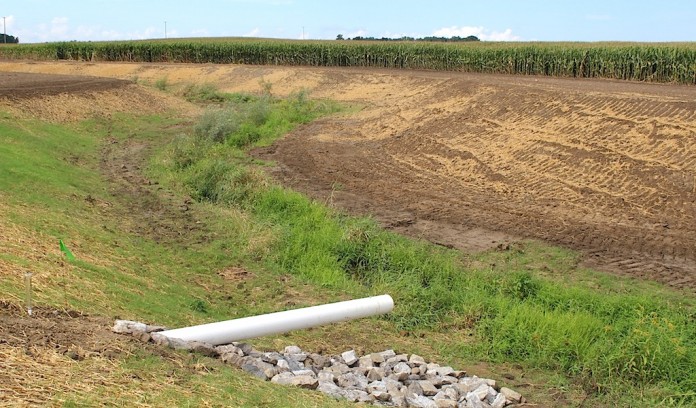WASHINGTON — The U.S. Department of Agriculture announced new funding for water quality efforts in the Western Lake Erie Basin, and released a study that says voluntary practices are making a difference, during a March 28 press conference at Maumee Bay State Park.
USDA will invest $41 million in a three-year initiative to support the ongoing work of farmers in Ohio, Michigan and Indiana. The initiative helps farmers implement conservation measures to reduce runoff.
The funding is in addition to the $36 million the agency had already planned to make available through the 2014 farm bill, for a combined three-year investment of $77 million.
More conservation
Farmers and landowners will be able to add conservation measures to about 870,000 acres in this watershed, effectively doubling the acres of conservation treatment that can be accomplished in the three years.
Significant progress
On the same day, the Natural Resources Conservation Service released a new report through its Conservation Effects Assessment Project (CEAP), that evaluates the impacts of voluntary conservation.
The report, based on farmer survey data in the Western Lake Erie Basin, shows voluntary conservation is making headway in reducing nutrient and sediment loss from farms, but there is opportunity to improve conservation management across the basin.
Related: University study says farmers must do more, or grow grass.
According to the report, the new initiative will help landowners reduce phosphorus runoff from farms by more than 640,000 pounds each year and reduce sediment loss by over 260,000 tons over the course of the three-year investment.
“Throughout the basin, comprehensive field-scale conservation planning and conservation systems are needed to accommodate different treatment needs while maintaining productivity,” said NRCS Chief Jason Weller.
“While voluntary conservation is making a difference in the basin, the CEAP evaluation tells us that there are still gains that can be made through an emphasis on practices like precision agriculture.”
The results
The conservation improvements now cover more than 580,000 acres, and have resulted in reduced annual nutrient and sediment losses of an estimated 7 million pounds of nitrogen, 1.2 million pounds of phosphorous, and 488,000 tons of sediment between 2009 and 2014.
For more information, visit https://medium.com/usda-results.
Key report findings:
(The following are the key findings found in the USDA’s March 28 study of voluntary conservation practices in the western basin of Lake Erie:)
• Farmers maintained conservation practices, cropland acreage, and crop mixes despite higher commodity prices. Between the 2003-06 and the 2012 CEAP surveys (Conservation Effects Assessment Project), average corn prices nearly tripled, rising to $6.67 per bushel, and average soybean prices nearly doubled, rising to $13.24 per bushel. Despite these increases, cultivated cropland acreage and crop mixes did not change significantly between the two surveys. Average annual phosphorus application rates decreased from 21.5 pounds per acre in 2003-06 to 18.7 pounds in 2012.
• Application methods that reduce the risk of phosphorus runoff increased from being in use on 45 percent of acres to being in use on 60 percent of acres, and edge-of-field trapping practices that reduce runoff losses, such as filter strips, increased from being in use on 18 percent of acres to being in use on 31 percent of acres.
• Voluntary conservation is making headway. Compared to a scenario simulating the removal of all conservation practices in Western Lake Erie Basin (WLEB), conservation practices in use in 2012 reduce annual sediment losses by 81 percent (9.1 million tons per year), reduce total nitrogen losses by 36 percent (40.6 million pounds per year), and reduce total phosphorus losses by 75 percent (11.4 million pounds per year).
In the 2012 conservation condition, harvested crops remove an average of 16.3 pounds of phosphorus per acre per year, which is 87 percent of the average phosphorus applied per acre annually (18.7 pounds). Simulations suggest average annual total phosphorus loss is 1.9 pounds per acre with 1.3 pounds lost via subsurface pathways, primarily tile drainage; .5 pounds of phosphorus remain on the field as legacy phosphorus, which may reside in the soil for years, be used by a following crop, or eventually be lost from the field. In the 2012 survey, farmers report phosphorus application rates at or below crop removal rates on 58 percent of acres, indicating some level of phosphorus mining of the in-field legacy load.
• No single conservation solution will meet the needs of each field and farm. Western Lake Erie Basin croplands are diverse in terms of soils, farm fields, farming operations, and management, which creates differences in conservation needs and potential solutions. Soils that make up small portions of fields can be significant sources of nutrient and sediment loss, especially when their loss vulnerabilities differ from the vulnerabilities of the soils that make up the majority of the field. Comprehensive field-scale conservation planning and conservation systems are needed to accommodate different treatment needs within and across farm fields, while maintaining productivity.
• Additional progress in nutrient and erosion control will depend on advanced precision technologies. Nutrient and erosion control needs vary across cropped fields, requiring management of unique zones or soils within field boundaries. Precision agriculture techniques that involve potential yield effects, zoned or gridded soil testing, and variable fertilizer rates can help achieve additional nitrogen and phosphorus.










